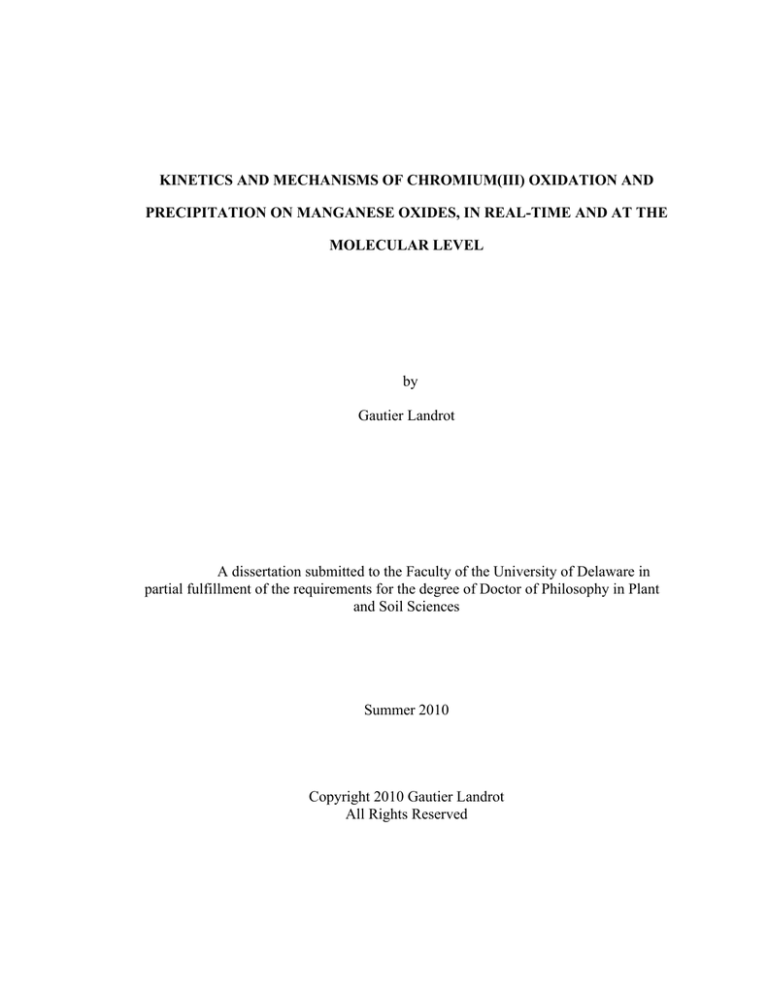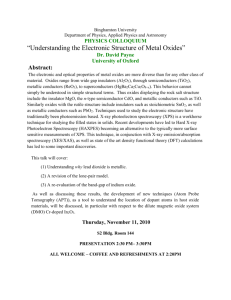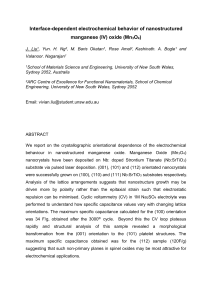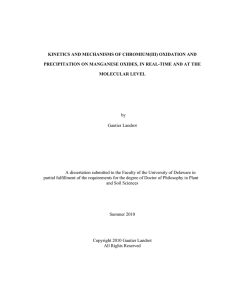
KINETICS AND MECHANISMS OF CHROMIUM(III) OXIDATION AND
PRECIPITATION ON MANGANESE OXIDES, IN REAL-TIME AND AT THE
MOLECULAR LEVEL
by
Gautier Landrot
A dissertation submitted to the Faculty of the University of Delaware in
partial fulfillment of the requirements for the degree of Doctor of Philosophy in Plant
and Soil Sciences
Summer 2010
Copyright 2010 Gautier Landrot
All Rights Reserved
ABSTRACT
The initial kinetics of Cr(III) oxidation on mineral surfaces is poorly
understood, yet a significant portion of the oxidation process occurs during the first
seconds of the reaction. In this study, the initial rates of Cr(III) oxidation on hydrous
manganese oxide (HMO) were measured at three different pH values (pH 2.5, 3, and
3.5), using a quick X-ray absorption fine structure spectroscopy (Q-XAFS) batch
method. The calculated rate constants were 0.201, 0.242, and 0.322 M-1 s-1 at pH 2.5,
3, and 3.5, respectively. These values were independent of both [Cr(III)] and [Mn(II)]
and mixing speed, suggesting that the reaction was “chemically” controlled and not
dependent upon diffusion at the time period the rate parameters were measured. A
second-order overall rate was found at three pH values. This represents the first study
to determine the chemical kinetics of Cr(III) oxidation on Mn-oxides. The results have
important implications for the determination of rapid, environmentally important
reactions that cannot be measured with traditional batch and flow techniques. An
understanding of these reactions is critical to predicting the fate of contaminants in
aquatic and terrestrial environments.
Additionally, this study investigated the kinetics and mechanisms of the
reactions occurring during chromium(III) sorption on three hexagonal manganese(IV)
oxide surfaces. Bulk Extended X-ray Absorption Fine Structure spectroscopy
(EXAFS) analyses show that trivalent chromium binds to the mineral surface in an
inner-sphere complex on the edges of the manganese oxide layers, and rapidly
oxidizes to Cr(VI), which can weakly bind to the surface in an outer sphere complex,
xvi
or diffuse to solution. As more Cr(III) sorbs on Mn(IV)O2, Cr(III) nucleation occurs
on the mineral and simultaneously Cr(VI) oxidation rates decrease. Chromium(III)
may precipitate locally on the mineral surface as a γ-CrOOH phase and extend away
from the manganese oxide, if the mineral surface is saturated with ions at high ionic
strength. Alternatively, Cr(III) can epitaxially nucleate in a α-CrOOH phase on the top
of Mn(IV)O2 layers, due to structural similarities between the surfaces of the Cr(III)
precipitate and the manganese oxide. After forming, Cr(III) precipitates can desorb
from the mineral surface, since more Cr(III) nucleation products are detected in
solution than on the solid phase. Quick X-ray Absorption Fine Structure spectroscopy
(Q-XAFS) enables us to measure in situ the rates of both surface precipitation
formation on manganese oxides and Cr(III) oxidation occurring in the entire batch
system. The α-CrOOH phase can quickly form at high pH at the early stage of Cr(III)
sorption on manganese oxides, thus competing with the rapid Cr(III) oxidation for free
Cr(III) monomers in solution. Additionally, the phase can quickly reach high
concentrations in the system, thus acting as a sink for Cr(III) ions. Therefore, since
both Cr(III) nucleation and Cr(III) oxidation occur rapidly and potentially have
opposite effects on Cr toxicity in the environment, this study, which measures for the
first time the rates of Cr surface precipitation on manganese oxide surface using QXAFS, demonstrates the need for developing new techniques that can follow the
kinetics of rapid reactions occurring in the environment.
Lastly, the speciation of As and Cr in a contaminated soil was studied by
micro x-ray fluorescence spectroscopy (µ-XRF), and bulk x-ray absorption
spectroscopy (bulk XAFS). The soil was taken from a park in Wilmington, DE, which
used to be an important center for the leather tanning industry along the Atlantic
xvii
seaboard of the United States, until the early 20th century. The concentrations of As,
Cr, and Pb measured at different locations in the park were often far above the
background levels of these heavy metals in the State of Delaware. Results from micro
x-ray absorption near-edge structure spectroscopy (µ-XANES) and bulk XAFS
analyses show that Cr(III) and As(V) are mainly present in the soil, with insignificant
amounts of Cr(VI) and As(III). The apparent absence of chromate may be notably due
to the association between Cr and Fe in different regions of the soil. Micro x-ray
fluorescence spectroscopy (µ-XRF) maps show that these two elements are distributed
together in regions where their concentrations are diffuse, and at local spots where
their concentrations are high. Iron(II) oxides, which can reduce Cr(VI) to Cr(III), are
present at some of these hot spots where Cr and Fe are highly concentrated, based on
the results obtained by micro x-ray diffraction spectroscopy (µ-XRD) analyses.
Results from bulk extended x-ray absorption fine structure spectroscopy (EXAFS)
analyses suggest that As is mainly associated with Al in the soil, and to a minor extent
with Fe, which is supported by µ-XRF and µ-XRD results. Arsenate may be sorbed to
aluminum oxides, which might have transformed after a long period of time into an
As-Al precipitate phase, having a structure and chemical composition similar to
mansfieldite. The latter hypothesis is supported by the fact that only a small amount of
As present in the soil was desorbed using the characteristic toxicity leaching procedure
(TCLP) and the synthetic precipitation leaching procedure (SPLP) tests. This suggests
that As is immobilized in the soil.
xviii











